Georges Perec followed his masterful novel La Disparition, a lipogram without the letter E, with Les Revenentes, which avoided all vowels except E. And Les Revenentes is hilarious, bending all rules of grammar, spelling, and syntax in its rigorous pursuit of univocalism (and becoming increasingly smutty in the process).
But there is a stray O. It was apparently not intentional, just a typo. Remember, univocalists: be diligent! It’s on page 81 of my copy (Julliard, 1991).
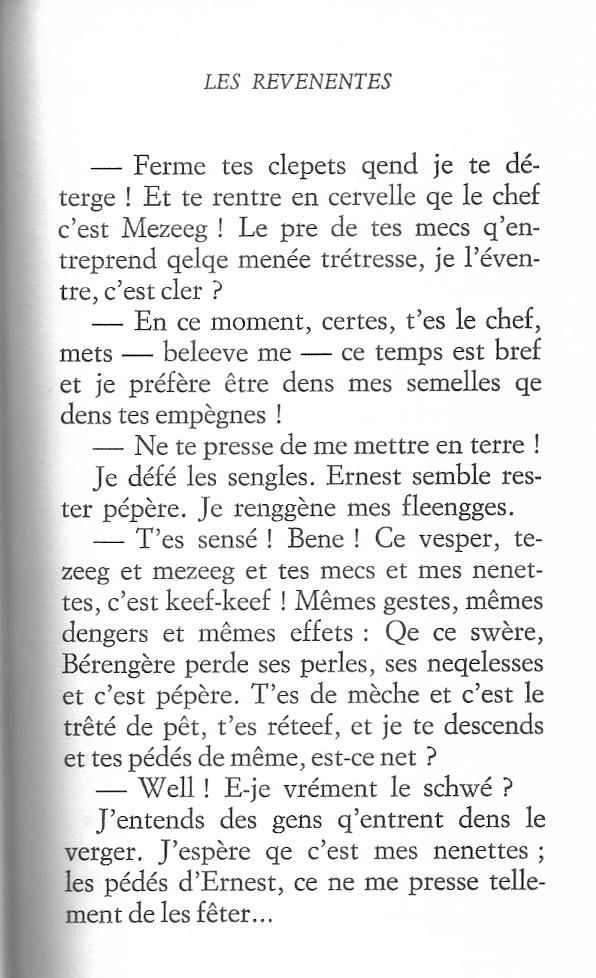
Tags: Literature
August 7th, 2014 · Comments Off on Children’s Card Games (205)
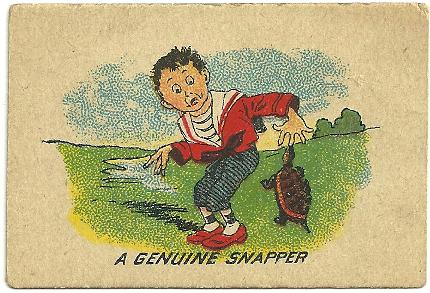
One card from an old “Snap” deck: no date or publisher given. Vivid colors!
(Posted by Doug Skinner)
Tags: Card Games
July 28th, 2014 · Comments Off on Bulletin (29)
First of all, we’re happy to announce that the Ullage Group is planning another event, after prolonged torpor. It will focus on one of Charles Fort’s favorite topics, volcanoes, and is slated for the fall. Details will follow.
Some of my comic art will be included in a show at Dixon Place (in Manhattan) in August, organized by R. Sikoryak. I will also project and read excerpts from my book The Unknown Adjective in Mr. Sikoryak’s show Carousel, also at Dixon Place, on September 3.
I will also present an evening of my songs, at Brooklyn’s Jalopy Theater, on September 13. I will be joined by Doug Roesch (guitar), David Gold (viola), and Ralph Hamperian (tuba).
My edition of Alphonse Allais’s plays is due out in August from Black Scat Books. It includes translations of ten monologues, three one-acts, and twelve shorter dialogues, skits and burlesques drawn from Allais’s columns. It’s proto-Dada at its most delicious!
I have also contributed to other upcoming publications from Black Scat: a short story (“Hardwood Mulch”) to Black Scat Review; and a homophonic translation, an alphabet, and a univocalism (“A Homophonous Restoration of the King James Text of Psalm 23,” “Hybrids,” and “Gus Fucks Lulu”) to Oulipo Pornobongo.
The definitive book on Richard Shaver’s artwork is in the works. There will be two volumes, from Shavertron Books; I will provide the introduction for the second.
Lastly, Michael Smith and I continue to work on a DVD collecting the puppet shows we performed in the ’90s. If all goes as planned, it will be included in a larger collection of Mike’s work, and also released separately.
(Posted by Doug Skinner)
Tags: Bulletins
July 23rd, 2014 · Comments Off on The Complete Works of Alphonse Allais (10-11)
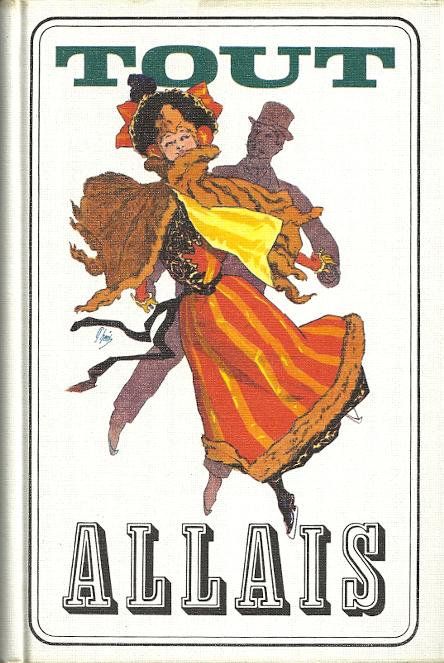
The seventh volume of Allais’s posthumous works (499 pp., 1969) contains his weekly columns for Le Sourire, 1901-1904.
The cover art is taken from a poster by Jules Chéret for the Palais de Glace (Ice Palace).

The eighth and final volume of the posthumous works (641 pp., 1970) collects the following:
Allais’s weekly columns for Le Sourire, 1905, ending with his last, on October 21.
Additional columns from Gil Blas, Fantasio, and Le Tintamarre; a letter to his mother, and a poem not discovered until 1930.
The novel L’Affaire Blaireau (The Blaireau Affair), from 1899. Allais reworked it from a play, Innocent, he had written with Alfred Capus in 1896. The plot revolves around a poacher, Blaireau, wrongly convicted of assaulting a policeman, and the ensuing complications.
Another novel, Le Boomerang, ou Rien n’est mal qui finit bien (The Boomerang, or All Is Not Bad That Finishes Well), serialized in 1903, and published as a book in 1912. Although released under Allais’s name, it was ghost-written (Allais referred to the book’s “young confectioner”), and based on the short plays Silvérie and Le Pauvre Bougre et le Bon Génie (The Miserable Wretch and the Good Genie).
There are also three plays: The aforementioned one-act, Le Pauvre Bougre, from 1899; another one-act, Congé Amiable (Friendly Departure), written with Tristan Bernard in 1903; and a three-act farce, Monsieur La Pudeur (Mister Prude), written with Paul Bonhomme and Félix Galipaux in 1903.
Allais’s other plays, all collaborations, and often with little contribution on his part except his name, are described, but omitted. They are, for the curious:
Au Moulin de la Galette, with Jehan Serrazin and Jules Desmarquoy, 1889. A revue for the eponymous cabaret.
Revue libre (Free Revue), with many others, 1890. Another revue, for the Hôtel Continental.
Innocent, with Alfred Capus, 1896.
Silvérie, ou le Les Fonds hollandis (Silvérie, or the Dutch Fund), with Tristan Bernard, 1898. Based on Allais’s story Simple Malentendu (Simple Misunderstanding), from 1890.
A la gare comme à la gare (At the Station as at the Station, a pun on the proverbial expression A la guerre comme à la guerre, At War as at War), with Albert René, 1899.
L’Astiqueur, ou Patience et longueur de temps font plus que force ni que rage (The Polisher, or Patience and the Passage of Time Do More Than Force or Rage), with Albert René, 1900.
Eh! Placide! Eh! Généreux!, with Albert René, 1901. Another revue; only René’s songs have survived.
Chat-Mauve Revue, with Albert René and Paul Bonhomme, 1904.
Les Cinq Sens (The Five Senses), with E. Favart and Albert René, 1904. Presumed lost.
La Partie de Dominos (The Game of Dominoes), with Sacha Guitry, 1907. Based on Allais’s early story, Un drame bien parisien (A Very Parisian Drama).
Le Petit Café, with Tristan Bernard and Ernest La Jeunesse, 1911. Originally written in 1899, but not performed until 1911.
The cover is taken from a poster for the Théâtre Libre, by Toulouse-Lautrec.
(Posted by Doug Skinner)
Tags: Alphonse Allais · Literature
July 14th, 2014 · Comments Off on The Complete Works of Alphonse Allais (7-9)

The fourth volume of Allais’s posthumous works (1968, 484 pp.) collects his column, La Vie Drôle, from Le Journal, 1897 to 1901. The cover is attributed to Massin.

The fifth volume of posthumous Allais (1968, 489 pp.) collects his contributions to Le Journal from 1901 to 1904. The cover is again attributed to Massin. The introduction of the automobile inspired many of Allais’s columns in those years, including the debate about whether new compound words should use moto rather than auto (such as motoroute, instead of autoroute).

The sixth posthumous volume (1969, 488 pp.) contains Allais’s contributions to Le Journal, from 1904 and 1905, and his columns for Le Sourire, from 1899 and 1900.
The cover is based on a lithograph by Gustave Henri Jossot, from L’Assiette au Beurre, 1907. The terrace of a cafe was Allais’s favorite place; he once said it was how he imagined paradise, where you could sit and drink, and watch people go by.
(Posted by Doug Skinner)
Tags: 'pataphysics · Alphonse Allais · Literature
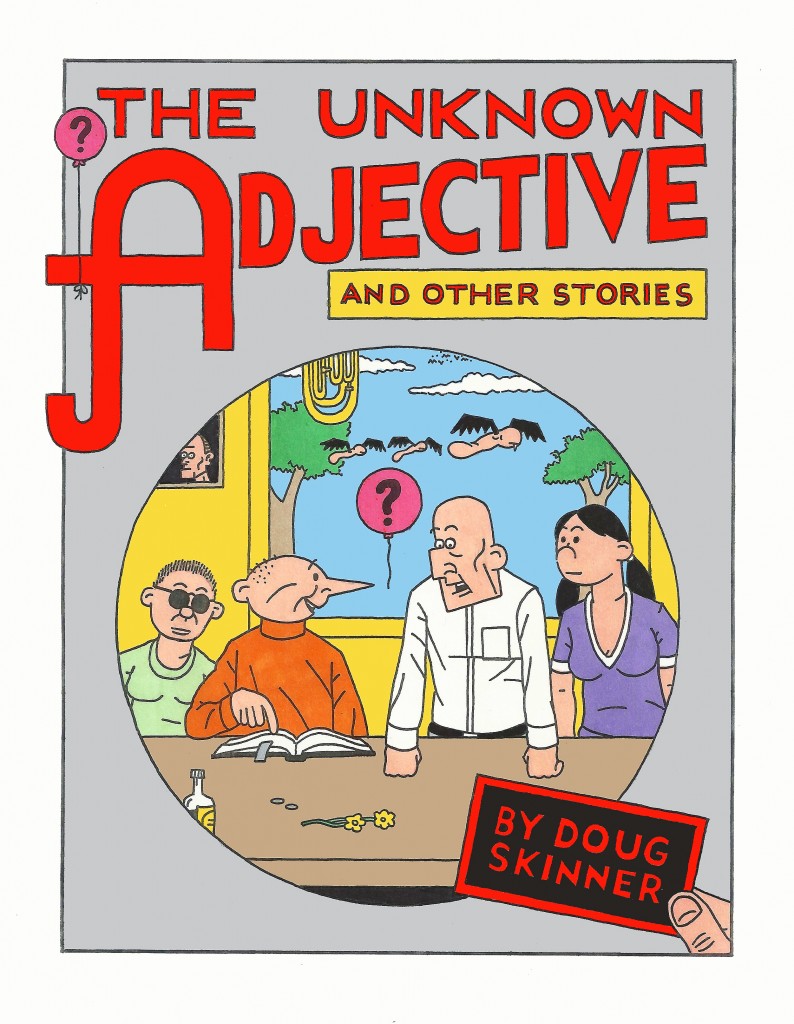
The Unknown Adjective has arrived!
“Mr. Skinner knows many terrible, terrible secrets about us. We are once again fortunate that he chooses to share them so deftly and so altruistically.” —Mark Newgarden
“Witty and ingenious comics from the exceptionally-talented writer, musician, performer, ventriloquist, and cartoonist Doug Skinner. It’s exciting to finally have these little-seen strips available in one beautiful book. You may be reminded of Voltaire or Ernie Bushmiller while reading these meticulously drawn stories featuring utterly hapless characters, but Mr. Skinner has a style all his own.” — R. Sikoryak
Will Walter and Benny find the elusive batworm? What really goes on out in “Cowboy Country”? And can Dr. Docket find a cure for all that ails Mr. Pert? You’ll discover the answers to these and other burning questions in this profusely illustrated collection of comics and picture stories from the brilliant (albeit peculiar) mind of Doug Skinner. Take a look inside and see for yourself. Your daily dilemmas will soon seem inconsequential, and the laughter you hear may turn out to be your own.
BLACK SCAT BOOKS proudly presents Doug Skinner‘s curious comics in a large format (10 x 8 x 0.3 inches) trade paperback edition, featuring over 100 pages of wicked strips designed to disrupt “normal” thought patterns.
Available from Black Scat Books.
(Posted by Doug Skinner)
Tags: Books
June 30th, 2014 · Comments Off on The Complete Works of Alphonse Allais (4-6)
The rest of François Caradec’s edition of Alphonse Allais’s works is devoted to the “posthumous works.” The term is not quite accurate; almost all of the material was published in Allais’s lifetime. However, it wasn’t included in the collections that Allais himself called his “anthumous works.” By Caradec’s count, there are 1,887 articles, novels, pamphlets, and plays.
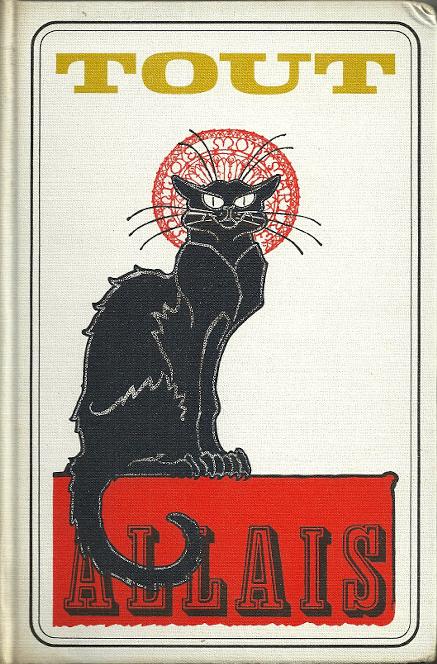
The first volume (1966, 440 pp.) contains an assortment of early writings. First of all, Allais’s contributions to Le Tintamarre (Uproar) from 1879 to 1884, mostly short jokes and squibs. He specialized in a couple of forms: the autographe, a one-liner ending in a pun on a well-known name, and the comble (acme), some of which I’ve translated here.
There is a brief assortment of letters from Allais’s youth, particularly to his family. Notable among these is a burlesque serial, “Le Petit Marquoir,” written for “Mademoiselle Marie,” a friend of his sister.
There are a few scattered contributions to Les Ecoles (1877-1878), La Revue Moderne et Naturaliste (1879), L’Hydropathe (1879), Le Tout-Paris (1880), and L’Anti-Concierge (1881-1882).
Most of the book, however, is taken up with his contributions to Le Chat Noir, the weekly paper published by Rodolphe Salis’s legendary cabaret. This volume collects material from 1882 to 1887.
The cover illustration is Théophile Alexandre Steinlen’s poster for Le Chat Noir.
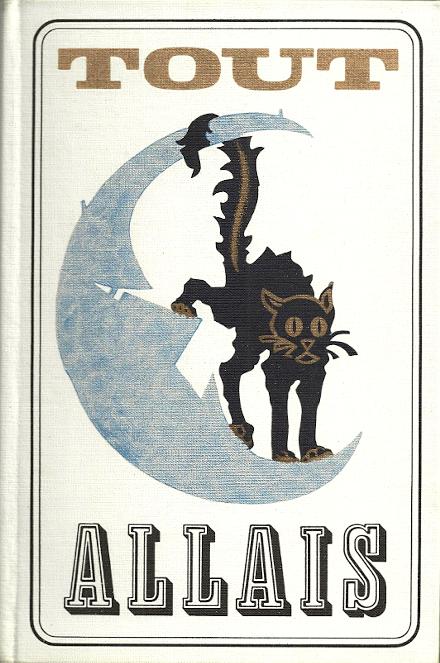
This second volume (1966, 381 pp.) contains the rest of Allais’s contributions to Le Chat Noir, from 1888 to 1896.
There are also a few articles from Le Courrier Français (The French Mail) from 1885 to 1893, and Le Mirliton (The Kazoo), from 1886 to 1895. The latter was the organ of Aristide Bruant’s cabaret; Allais and Bruant were apparently quite friendly.
Closing the volume is the curious Album Primo-Avrilesque (April-Foolish Album) from 1897, which collects the monochromatic paintings Allais exhibited at the Arts Incohérents, as well as his piece of silent music, the “Funeral March Composed for a Great Man Who Was Deaf.”
The cover illustration is the sign that hung outside Le Chat Noir, by Adolphe Willette.
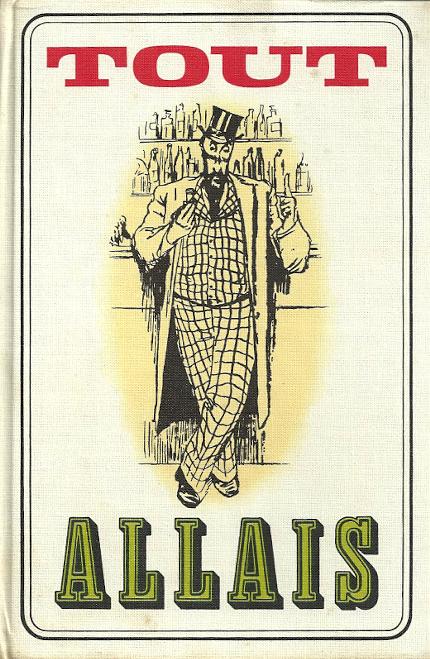
The third posthumous volume (1967, 488 pp.) collects “La Vie Drôle” (“The Funny Life”), the column that Allais wrote twice a week for the Parisian paper Le Journal. This volume covers the years 1892 to 1897.
The cover sports a caricature by Jean Veber, which appeared in Le Journal in 1896.
(Posted by Doug Skinner)
Tags: 'pataphysics · Alphonse Allais · Literature
Since so little is available in English about Alphonse Allais, and since I’m translating him, I think it would be useful to post a description of his complete works. The standard edition was edited by François Caradec, and published by La Table Ronde in eleven volumes, from 1964 to 1970. I’ll summarize it in four posts, unless anyone objects.

Volume 1 (1964, 604 pp.) contains the first five collections of what Allais called his “anthumous works.” Each contains short pieces culled from his contributions to various Parisian periodicals. A se tordre (Double Over) (1891) was the first, with 45 pieces, drawn largely from Le Chat Noir. Although Allais also wrote serious short stories early in his career, with this first book he established himself primarily as a humorist.
Vive la Vie! (1892) was a smaller collection, with 29 pieces.
Pas de Bile! (No Bile!) (1893) collected 39 pieces.
Le parapluie de l’escouade (The Squadron’s Umbrella) (1893) also collected 39 pieces. The title refers to a traditional joke for a new recruit: he was sent to bring back the squadron’s umbrella.
Rose et Vert-Pomme (Pink and Apple-Green) (1894) contained 44 pieces.
This first volume also has an introduction and an illustrated chronology of Allais’s life, both by Caradec. The cover caricature was drawn by Leonetto Cappiello in 1900.
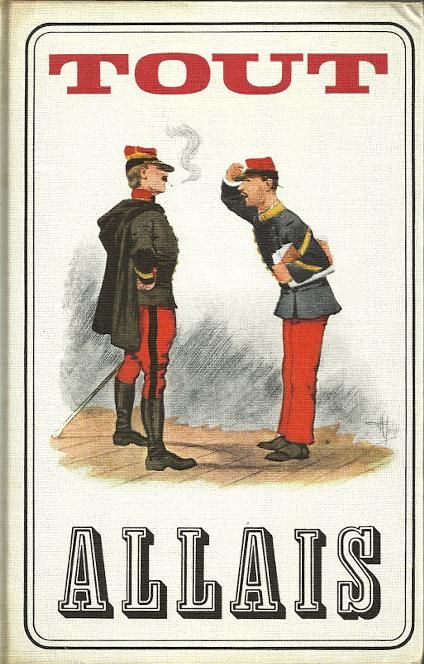
Volume 2 (1967, 478 pp.) contains the next three volumes of the anthumous works.
2 + 2 = 5 (1895) collected 65 stories.
On n’est pas des boeufs (We Are Not Cattle) (1896) collected 44 stories.
And Le bec en l’air (The Nose in the Air) (1897) collected 51 stories.
The cover illustration is by Albert Gullaume, from My 28 Days, 1898. Guillaume and Allais had traveled to Chicago together in 1893 to report on the Exposition; Guillaume later quarreled with Allais when the latter signed an “anarchist” petition.
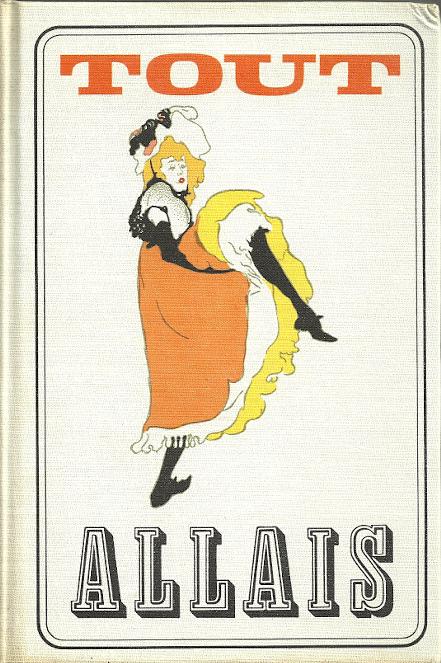
Volume 3 (1968, 525 pp.) contains the last four anthumous books.
Amours, délices, et orgues (Loves, Delights, and Organs) (1898) collects 47 stories. The title is made up of the three words in French that are masculine in the singular and feminine in the plural.
Pour cause de fin de bail (Because the Rent Is Due) (1899) contains 54 pieces.
Ne nous frappons pas (Let Us Not Hit One Another) (1900) collects 58 pieces.
Allais’s final collection, Le Captain Cap (1902) was devoted to the exploits of his friend Captain Cap, Albert Caperon, who often appeared in Allais’s stories. It includes a dossier on Caperon’s run for parliament in 1893, as well as 47 stories about Cap, many reprinted from earlier collections, and several rewritten to include the Captain. My illustrated translation is available from Black Scat Books.
The cover illustration is Toulouse-Lautrec’s drawing of the dancer Jane Avril, who was tied romantically to Allais from about 1892 to 1894.
(Posted by Doug Skinner)
Tags: 'pataphysics · Alphonse Allais · Literature
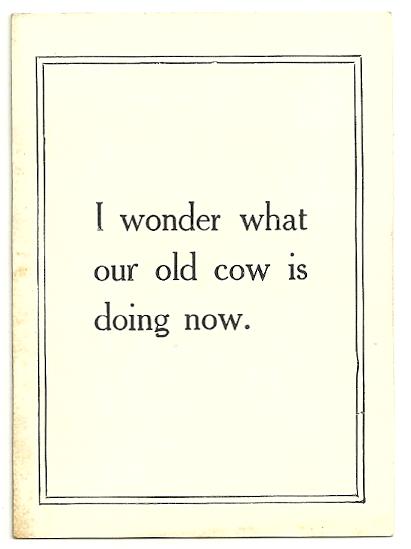
“How Silas Popped the Question,” published in 1915 by Parker Brothers, was another precursor of “Mad Libs,” like the other early games “Dr. Quack” and “Peter Coddle.” One player reads the story of Silas’s attempts to overcome his shyness and propose to Sally, and the others read cards giving his many unromantic attempts at conversation. “The one who laughs most wins!”
It came in a handsome box.
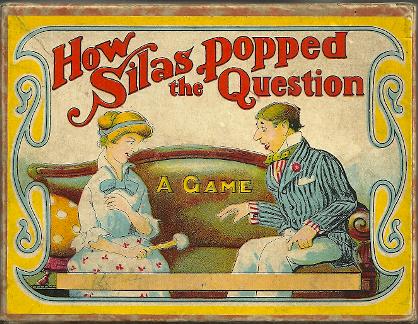
(Posted by Doug Skinner)
Tags: Card Games
In the late 1940s, fans and followers of Richard Shaver tried to research his claims. Some of them tried to find their way into the caves he had described; others tried to build the machines that he claimed the cavern races used underground. Of the latter, most concentrated on the telaug, or telepathy augmenter, or on the ben ray, a healing device. Ralph Holland, however, came up with this “exd motor,” which was published in the The Shaver Mystery Magazine, Volume 3, Number 1, in 1949.
“Exd,” in Shaver’s physics, was star ash, the residue of dead stars, which fell to earth and caused gravity. The idea wasn’t original; it had been championed in the 18th century by Georges-Louis Le Sage, among others. Holland offered a motor which was powered by exd.
Holland also claims that he studied it by dismantling one of the vehicles used by the cavern races. This seems unlikely; perhaps the answer lies with his collaborator, Ira Amenophis (that last name being the Greek form of Amenhotep). Holland, along with other Shaverites, claimed to be in psychic or telaug contact with some of those subterraneans. Ira was one of those, so perhaps he supplied the information.
I don’t think anyone tried to build this. According to the account, it was made of a particularly dense, unknown metal, and required an unknown power storage unit. You’re welcome to experiment.
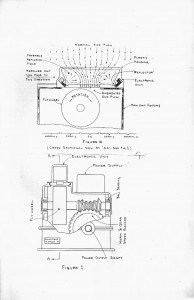
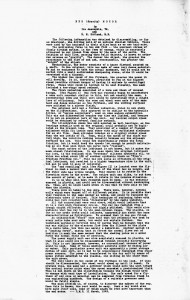
(Posted by Doug Skinner)
Tags: Literature


















